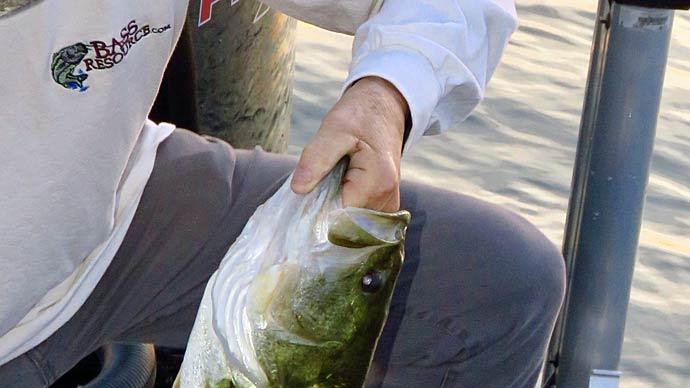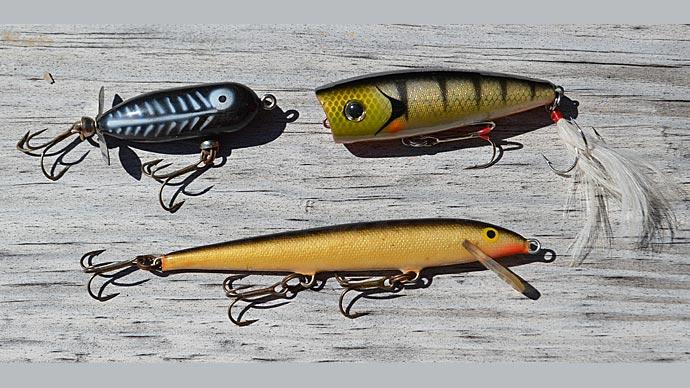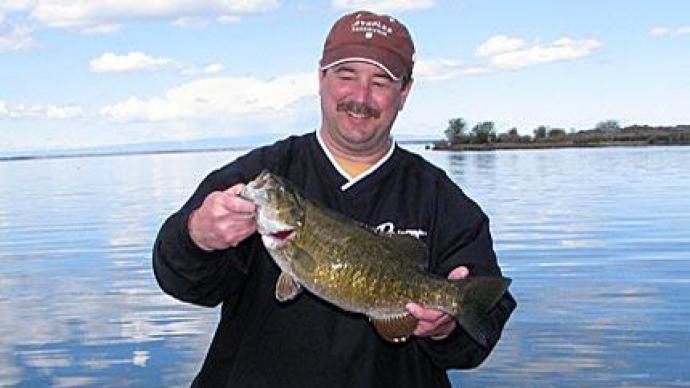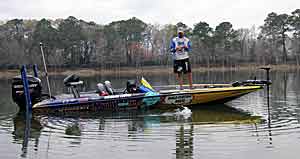
A benefit of living in the South is that you can bass fish from your boat year-round. True, during winter, you have to deal with frozen guides on your rods, and sometimes you can’t even get them out of the locker, last night’s frost freezing it shut. Mid-winter days on the lake are often tough going. You fish for hours, slowly dragging jigs or bumping small crankbaits along the bottom between bites. That gives ample time for your thoughts to wander to warmer days and faster fishing action, including fishing topwater lures.
Every angler loves big blowups that are topwater strikes. You never know when one will come, so you must always be alert. That’s fishing excitement at its best. So between dealing with ice and blowing on your hands to warm them, it’s only natural that you wonder how you can fish topwater lures more often. Traditionally, it has been a warm-water technique, best done early in the morning or late in the evening, when the horizon snuffs out the last flickers of sun. But those aren’t the only times. These lures can catch bass in early spring and late fall. They might not be the most effective lure or the one that catches the biggest bass during those seasonal extremes, but they will produce. And one last blow-up might be enough to get you through a long, cold winter.
Brandon Lester knows about getting the most out of topwaters. The Fayetteville, Tenn., angler fished the Bassmaster Southern Opens in 2012 and 2013, doing well enough to qualify for the 2014 Bassmaster Elite Series, where his best finish so far is a 21st at Lake Seminole, which sits on the Georgia-Florida border. He said that stepping up to the Tour level has been an experience. He knew the competition would be more challenging but to what degree has been a surprise. “It has been great. But if you don’t catch them every day, they will beat your head to the ground. It’s a whole new world. It’s a different league.” He could expect the weights to drop off in the Opens after Day 1. In the Elites, they go up. When he stopped to talk topwater fishing, he had just finished a turkey hunt and was headed west to his next Elite event on Table Rock Lake in Missouri. That lake is similar to the ones he fishes at home in south-central Tennessee, and he was looking forward to some familiar fishing and a good finish.
To get an idea of how far you can push topwater fishing, you first need to figure out when it’s at its best. Lester said his favorite time to fish topwaters is spring when the water temperature is about 65 degrees. Most years, that happens about mid-April on his home lakes. That’s when anglers historically go to shallow flats, rig up small, soft-plastic baits and start looking for bedding bass. But he said getting locked into fishing that one way can be a mistake. Other shallow-water cover such as laydowns, docks, or grass beds can hold bass that are going on or coming off beds. Topwaters can be a great way to catch those bass because they can be fished faster, allowing you to cover more water. And many represent vulnerable prey, igniting neutral bass to feed.
“My favorite topwater bait is a Heddon Super Spook Junior,” Lester said. And when he says it’s his favorite, he means that’s the topwater lure he throws. He might mess around with a popper or a frog once in a while, but he doesn’t stray far from walking the dog. Maybe that explains why “Headstrong” by Trap is his intro song at Elite events. He believes the Super Spook Junior’s sound, action, and profile combine to trigger more bites in more situations. Rarely does he fish down a bank with it. Instead, he’s always making tight casts to specific targets, like you would a spinnerbait or square-bill crankbait. He will fish in clear water a little faster, but most of the time, it’s just a steady retrieve. “I’ve tried a lot of colors, but the bone color is my favorite.” Smallmouth fishing calls for a color modification: He’ll add chartreuse somewhere on the bait. That change is made during any season, but one trick plays best in post-spawn for any bass species. He’ll swap out the rear hook for a feathered one. He’s not sure why, but its extra flutter grabs the attention of bass guarding fry. They nip at the feathers, pulling the bait down. Usually, that’s enough to get a hook in them.
Lester doesn’t wait till the magic 65 degrees to start throwing his favorite topwater bait. “If I can get up in a spawning pocket and see some fish cruising, I will try it.” That can occur when water is still in the high 50s, and he adjusts by slowing his retrieve. But once the water is in the upper 50s, you have months of topwater fishing ahead of you. What if you can’t wait that long? What if you love topwater fishing so much that you want to fish it on, say, Valentine’s Day? That happened on a cold day in mid-February on Lake Wylie, an impoundment on the Catawba River near Charlotte, N.C. I idled into a small creek arm and found the water temperature about 50 degrees. A warm-water discharge from a power plant upstream kept it at that temperature. Bass were schooling on a shallow flat in the back of the creek arm. If I stayed back and made long casts, they would smash a small, clear popper with a feathered treble as long as I fished it slow. A spinnerbait or soft-plastic jerkbait might have been a better choice for numbers, but I was having too much fun getting topwater strikes, especially that time of year.
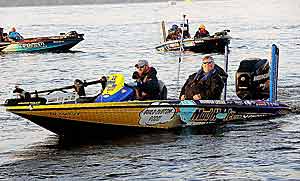
It doesn’t take much warmer water to start getting buzzbait bites. Those typically happen once the temperature gets to the mid-50s. It’s not a big-bass pattern, though you’ll catch them occasionally. Most of the bass you’ll catch are keeper-sized bucks, which are up shallow looking for a mate and a place to spawn. The best places to throw buzzbaits are shallow pockets off the main lake or creek. The bass are just coming shallow, so it’s essential to have a deep wintering area nearby. Also, you’ll need to keep your retrieves slow, and using a three- or four-bladed buzzer will make that easier.
In the country's northern reaches, it often takes a long time for spring’s warmth to arrive, but that shouldn’t delay your topwater fishing. On one early, sunny spring day on a northern, natural lake, I and two others were steadily catching bass on jerkbaits. The water temperature was about 50 degrees. One of my buddies reached into his tackle box and pulled out a Zara Spook. I remember my following words: “You’re never going to catch on that today.” He paid me no mind, tying it on and casting it across the submerged weedbed we were fishing. After it landed, he slowly started to sashay it back to the boat. A bass slurped it down about halfway through the retrieve. Granted, we were fishing the side of the lake that received the most sun, and it happened late in the afternoon, which most likely brought the warmest temperatures of the day. But it goes to show that you can never count out topwaters
Once summer hits, almost every angler has a topwater rigged for fishing in the mornings and evenings. Those are the traditional times to throw them, but you don’t have to put them down when the sun is high in the sky. The key to getting bites on them all day long is finding heavier cover — grass, wood, or current. A popper chugged along current-swept riprap is a reliable pattern in rivers or tidal systems. So are frogs hopped over matted grass or through thick cover. The closest lakes to Lester are Dale Hollow and Tims Ford Lake. The latter, about 10,000 acres in size, recently offered up a unique summer scenario for the hollow-bodied amphibians. “On my home lake, we had a lot of rain,” he said. “It was way up over summer pool, 7 to 8 feet.” All that water pushed the lake high enough to flood the trees along its shores. That made more places for bass to swim, but not for lures with treble hooks. So he tied on a frog, which he could skip into the brush without getting tangled. He walked it around the flooded cover, catching bass till the water receded.
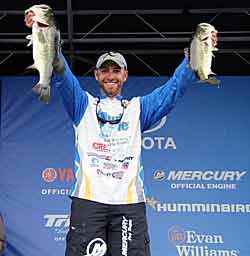
Autumn may be the best time of year to fish topwaters. On many lakes, bass migrate to the back of pockets and creeks, chasing shad. “In the fall, you’ll see schooling fish busting,” Lester said. “They’ll still bite [a topwater].” That activity will carry straight through winter but peak when the water temperature is in the low 50s. That’s a perfect situation to throw buzzbaits, poppers, and walking baits like a Zara Spook. Even a prop bait with a slim profile is a good choice.
The key to catching schooling bass is staying on them and matching the hatch. First, figure out where they are congregating. In a Northern lake, schooling smallmouth could be on the end of a shoal that forms a point or has a quick drop-off. In a Southern impoundment, schooling largemouth might be where two creek channels come together or on the tip of the longest point in a creek. If you watch long enough, you’ll see a pattern in where and when they push baitfish to the surface. Matching the hatch may take more work, mostly trial and error. Try adjusting the size of the lure and speed of your retrieve first. They seem to make the most significant difference.
Topwater gear can follow you through the year. One of Lester’s sponsors is Mud Hole Custom Tackle, a lure- and road-building supply company. For topwaters, he uses their 7-foot 2-inch medium-action MHX blanks, which are made from high-modulus graphite. Many anglers like a rod about 6 feet 6 inches for topwaters. But the extra length is essential to him for two reasons. First, longer rods are more comfortably cast with two hands, which means more accurate casts. Secondly, small movements in the handle translate to big ones in the tip. That leads to less fatigue when you are working a topwater lure. The days of pistol grip rods are over — though Mudhole sells them if you want to go old-school, like when tournament pioneer Charlie Campbell made Zara Spooks dance one direction or another. Lester had never messed with rod building before, but he said he always had an interest in giving it a try. Now that he has been exposed to it, he’s enjoying it and has found building a rod isn’t as hard as some anglers think.
A little success can be a dangerous thing. Just because you’ve had the best experiences with topwater lures during summer, don’t fish under the impression that’s the only time they will work. You can extend their usefulness earlier and later in the year with some adjustments. They might not load the boat or catch the biggest bass, but you can get a taste of the excitement that is enjoyed so much.


